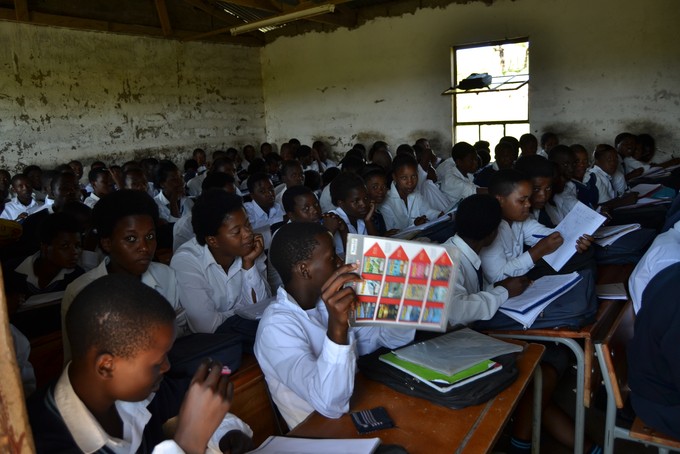Schools suffer while Eastern Cape fails to spend education budget
Infrastructure budget cut 12% after department underspends
Dalagubha Junior Secondary School near Libode has no piped water and the ceilings are broken. The high school nearby has broken windows, no ceilings in classrooms, and for part of the year classes are held under trees. Yet the Eastern Cape Department of Education is not spending its infrastructure budget.
Libode in the Eastern Cape is located between Mthatha and Port St Johns.
According to a statement by Equal Education, Finance Minister Pravin Gordhan has cut the Eastern Cape Education Infrastructure Grant (EIG) by 12%, from about R1.7 billion in the 2015/16 year to R1.5 billion in 2016/17. This is because the grant was underspent.
Andile Cele of Equal Education explains that for the year ending March 2015, the grant was underspent by R211 million. Then in the current financial year the Eastern Cape government did not get its fourth quarter EIG transfer because of underspending. “There aren’t actual spending figures for 2015/16 as the financial year only ends in March. But we can deduce that of the R1.7 billion EIG allocation, a quarter was not transferred,” Cele told GroundUp.
This underspending is something Madakhile Luswazi cannot understand.
Luswazi was involved when Dalagubha Junior Secondary School in Dalagubha location was started in 1971. First the parents used a small church, then five years later they by 1976 they decided to build their own school, little by little. Luswazi, who is a former member of the school governing body, said each house had paid R100.
“I still remember that day. We built one classroom then we told the teachers to bring the kids. We thought one classroom was going to be enough, but teachers told us they had children up to standard five. We then collected more money. Each house added R50. We managed to build eight classrooms from our pockets,” she said.
Each year parents pay to fix the ceilings, windows and cracks in the walls.
This school has no access to piped water. Students have to fetch water from the river and keep it in buckets, and this has to last for a few days. The area has taps but most have no water.
Many of the children walk seven kilometers or more to school every day.

“It pains me to hear there’s money the Department of Education failed to use while they should have built us a new school,” said Luswazi.
When GroundUp visited the school this week, the ceilings in all the classrooms were damaged. In two of the classrooms the sky was visible through the roof.
Grade seven learner Ezile Malangeni said when it rained the water came into the classroom and when it was windy she was afraid the roof might blow away.
“If there was another school in the area, I would change to it, but this is the only [nearby] school,” she said.
Dalagubha takes students from grade R to grade nine.
Teachers said the only thing the Department of Education provided was furniture.
In 1997 parents opened a high school too for the children of Libode, Xhentse Senior Secondary School. Again they used a lot of their own money.
The school has 297 students and caters for grade 10 to 12. All the classrooms are overcrowded, there are no ceilings and students complain about the heat, about the water which comes in when it rains, and about the broken windows.
One of the teachers said that each year the department promises to build a school but the promises turn out to be empty.
“Instead of building us a school they built us six toilets for the whole school,” he said.
Since 2011 the school had managed a matric pass rate of more than 80%, but last year the rate dropped to 57%.
The teacher said during exams, grade 12 students occupied all three classrooms, leaving the two other grades studying under trees.
Equal Education has called on the National Treasury to hold the Eastern Cape Education Department accountable for under-spending.
“Treasury cannot simply accept low spending – ultimately returned funds – from provinces. There needs to be penalties for this and a mechanism put in place to ensure that implementation plans are met. It is not enough to withhold funds, as this perpetuates the lack of delivery, and our children suffer the consequences. This is unacceptable,” the statement said.
GroundUp asked the Eastern Cape Department of Education to explain why the full amount of the grant had not been spent, when there were so many schools with poor infrastructure in the province, and to state which schools would be prioritised in future and why.
Mtima Mali, spokesperson for the department, replied: “Last year our infrastructure expenditure was at 92%. The outstanding percentage was due to a litany of reasons including late submission of invoices by contractors.”
This article was updated at 6:30pm on 3 March 2016 with comment from the Eastern Cape Department of Education.
Support independent journalism
Donate using Payfast

Don't miss out on the latest news
We respect your privacy, and promise we won't spam you.
Next: “What would you do if your sister was a sex worker?”
Previous: Inheritance: women are still cut out
© 2016 GroundUp. 
This article is licensed under a Creative Commons Attribution-NoDerivatives 4.0 International License.

